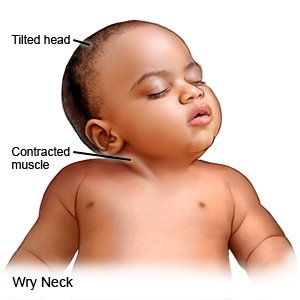Torticollis in Children
Medically reviewed by Drugs.com. Last updated on Aug 4, 2025.
AMBULATORY CARE:
Torticollis
is a condition that causes your child's head to stay turned or tilted in 1 direction. Torticollis may be congenital or acquired. Congenital means your child was born with torticollis or developed it soon after birth. Acquired means torticollis developed later as a sign of an injury or medical condition.
Common signs and symptoms of torticollis:
- Head tilting to 1 side and the chin pointing to the other shoulder
- Trouble moving the head from side to side or up and down
- Pain in the affected muscle
- A soft muscle lump that goes away before 6 months of age
- Vision problems, such as double vision or eyes that are pointed in different directions
- Nausea, vomiting, or a headache
- A flat area on 1 side of the head
- Wanting to breastfeed on only 1 side
- Hip dysplasia
 |
Call your local emergency number (911 in the US) if:
- Your child has sudden shortness of breath.
Seek care immediately if:
- Your child has swelling in his or her neck area that gets worse or does not go away.
- Your child has trouble moving his or her arms or legs.
- Your child's arms or legs feel numb.
- Your child has increased pain in his or her neck or shoulder.
- Your older child is drooling or having trouble swallowing.
Call your child's doctor if:
- Your child has a fever.
- You have questions or concerns about your child's condition or care.
Treatment:
Torticollis usually goes away on its own, but treatment may be needed if symptoms continue or worsen. Treatment depends on your child's age and the cause of his or her torticollis:
- Physical therapy may be used to teach your child body position changes and head rotation exercises. A therapist will show you how to move your infant or young child to help stretch and loosen the muscles. The therapist will tell you when to do the exercises and how often to do them.
- Medicines may help relieve pain or muscle spasms. Some medicines are only given to children 6 months or older. Your child's provider will tell you if medicine is right for your child. The provider will give you directions for when and how often to give each medicine.
- Surgery may be used to cut the nerves that supply the affected muscles, or to separate the muscles.
Treatment options
The following list of medications are related to or used in the treatment of this condition.
Help your child manage torticollis:
- Have your child rest as needed. Your child may return to daycare, school, or other daily activities as directed.
- Apply ice to decrease swelling and pain. Apply ice on your child's neck for 15 to 20 minutes every hour, or as directed. Use an ice pack, or put crushed ice in a plastic bag. Cover the bag with a towel before you apply it. Apply ice for as many days as directed.
- Apply heat to decrease pain and muscle spasms. Apply heat on your child's neck for 20 to 30 minutes every 2 hours, or as directed. Use a heat pack or a heating pad set on low. Apply heat for as many days as directed.
- Have your older child wear a cervical collar, if directed. A cervical collar helps support your child's neck. Your child's provider will tell you the kind of collar your child needs. Ask how long your child should use the collar each day, and for how many days.
Follow up with your child's doctor as directed:
Write down your questions so you remember to ask them during your visits.
© Copyright Merative 2025 Information is for End User's use only and may not be sold, redistributed or otherwise used for commercial purposes.
The above information is an educational aid only. It is not intended as medical advice for individual conditions or treatments. Talk to your doctor, nurse or pharmacist before following any medical regimen to see if it is safe and effective for you.
Learn more about Torticollis
Treatment options
Further information
Always consult your healthcare provider to ensure the information displayed on this page applies to your personal circumstances.
